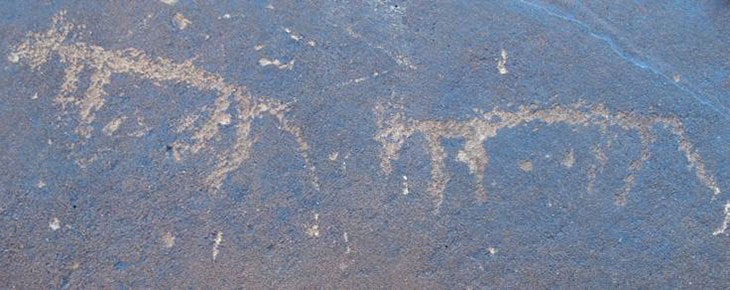
September 2017
John Vincent Bellezza
Welcome to another Flight of the Khyung, your time capsule to the Tibetan world of yore! This month’s newsletter supplies you with two more original articles on the rock art of the Western Tibetan Plateau. The first one, written by Devers et al., reviews the discovery of more than 350 rock art sites in Ladakh. The second feature spotlights carnivores in the rock art of Upper Tibet. The spectacle of tigers, wolves and other fierce animals shown alone, pursuing prey or participating in extraordinary doings brings prehistoric Tibet into sharp focus. The writing of the second article was sponsored by my friends Michael White & Susan McDonald. I heartily thank them for their support.
A Review of Rock Art Discoveries in Ladakh over the Last Fourteen Decades
Quentin Devers, Viraf Mehta and Tashi Ldawa
Of all Ladakkh’s surviving ancient cultural heritage, it is rock art, almost exclusively in the form of petroglyphs, that has received significant and almost continuous attention since they were first commented upon by Western scholars and researchers in the late 19th and early 20th centuries. In the past few decades many new sites have come to light, making Ladakh the largest rock art centre in the Tibetan cultural world. This article provides a chronological overview of research carried out on this topic.
In areas of high concentration, the definition of what constitutes a rock art site can vary considerably. Some may count distinct clusters of petroglyphs separated by hundreds of meters as different sites, while others may list them as sub-zones of a single site. In order to present a more coherent picture of the evolution of rock art discoveries, the authors of this work chose to retain the site-grouping system used by Bruneau in her dissertation about the rock art of Ladakh (Bruneau 2010).
In the late 19th century, several explorers noted the existence of rock carvings in Ladakh and Baltistan. The first written references were by Ujfalvy de Mezőkövesd, who described petroglyphs along the Suru River (Ujfalvy de Mezőkövesd 1884), and by Conway, who described others in Dras and Khaltse (Conway 1894).
The first study of significance was carried out by Francke over a hundred years ago (see bibliography for his works). Through his publications, he appears to have documented about thirty sites, primarily in the lower Indus valley (Fig. 1). Although he paid particular attention to the engravings of chortens and to other historical motifs, one of his main interests were carvings he thought pertained to the pre-Buddhist society of Ladakh. He also brought to light a number of inscriptions written in Kharosti and Brahmi, particularly in Khaltse and further downstream. He was helped in his endeavour by several individuals, notably Dr. F. E. Shaw, who pointed out to him a number of sites, like Tangtse. During his stay in Khaltse, Francke met Duncan, who came to publish the first pictures of rock art in the region at Balukhar (Duncan 1906).
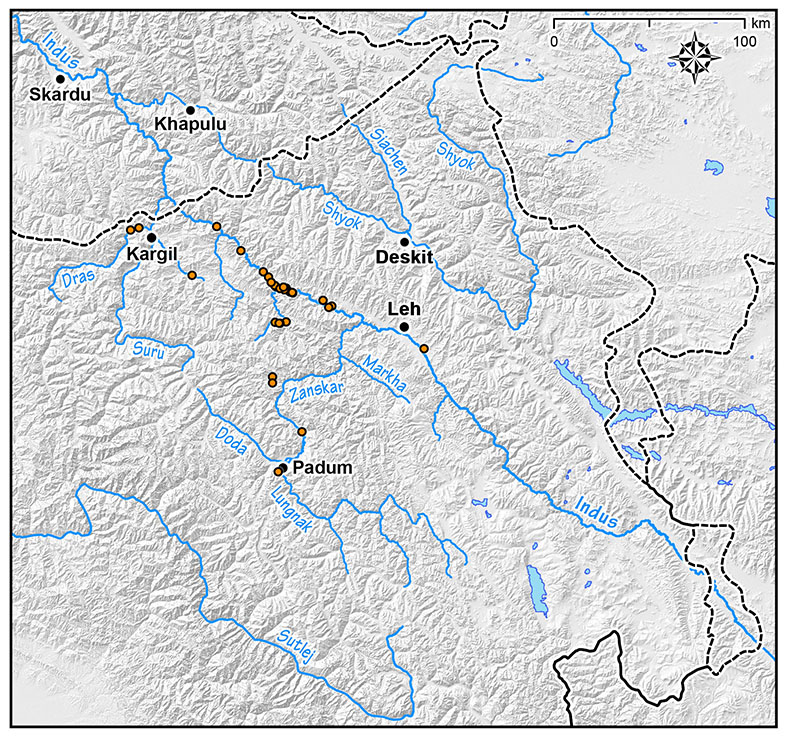
Fig. 1. The more than thirty rock art sites documented by Francke.
In the decades following Francke’s explorations, only a few other individuals are known to have studied the rock art of Ladakh. De Filippi (De Filippi 1932), Neve (Neve 1913), Roerich (Roerich 1931), and Dainelli (Dainelli 1933) documented sites mainly along the Indus valley, particularly around Khaltse. De Terra documented rock art sites in Nubra (De Terra 1931).
The closure of Ladakh to outside visitors from 1947–1974 hampered research but it has gathered momentum ever since. Peissel brought to light several sites in Zanskar (Peissel 1979), while Snellgrove and Skorupski published petroglyphs from Alchi and mentioned others elsewhere (Snellgrove and Skorupski 1980). Several archaeologists from the ASI (Archaeological Survey of India), such as Mani and Fonia, documented the existence of about forty sites in various regions of Ladakh (Director Archaeological Survey of India 1997, 2004). Parallel to these efforts, Vohra focused on the Brogpa areas of the Lower Indus valley, and on a few other areas, adding a dozen new sites to those known (Vohra 1994; 1995; 2005; 2005b). The MAFAC (Mission Archéologique Française en Asie Centrale) brought to light approximately a dozen new sites in the 1980s (Francfort, Klodzinski, and Mascle 1992; Bruneau 2010, vol. 4, pp. 7–22), and offered the first detailed analysis of Ladakhi rock art within a Central Asian context. Besides the work of these main researchers, more than a dozen other sites are noted in miscellaneous publications. All in all, there were a little over 100 sites published in the century since Francke opened the doors to rock art studies in Ladakh (Fig. 2).
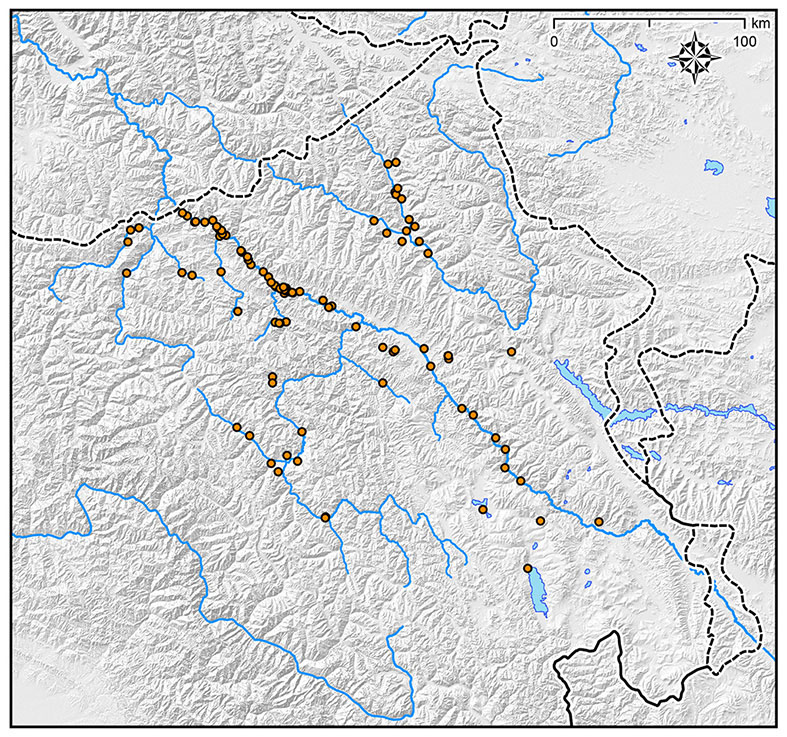
Fig. 2. The more than 100 rock art sites documented in literature until 2006.
A major step was taken in 1996 when Vernier started a ten-year fieldwork project aimed at systematically recording in a database every carving at every rock art site of Ladakh. Because of areas then restricted to foreigners, Vernier’s work was limited to Zanskar and to the Indus valley between Hanu and Ubshi, leaving out Purig, Nubra and the whole of Changthang (Fig. 3). In his 2007 book, Vernier lists a total of ninety-seven sites (Vernier 2007), which when regrouped by Bruneau amounted to eighty-eight sites, out of which sixty-nine were new discoveries. Vernier’s work was not interpretative, but it led to the creation of the first comprehensive classification of subjects and motifs in Ladakhi rock art (types of zoomorphs, types of anthropomorphs, etc.). It should be noted that the database he put together contained an impressive 9074 individual carvings (Bruneau 2010, vol. 1, p. 129).
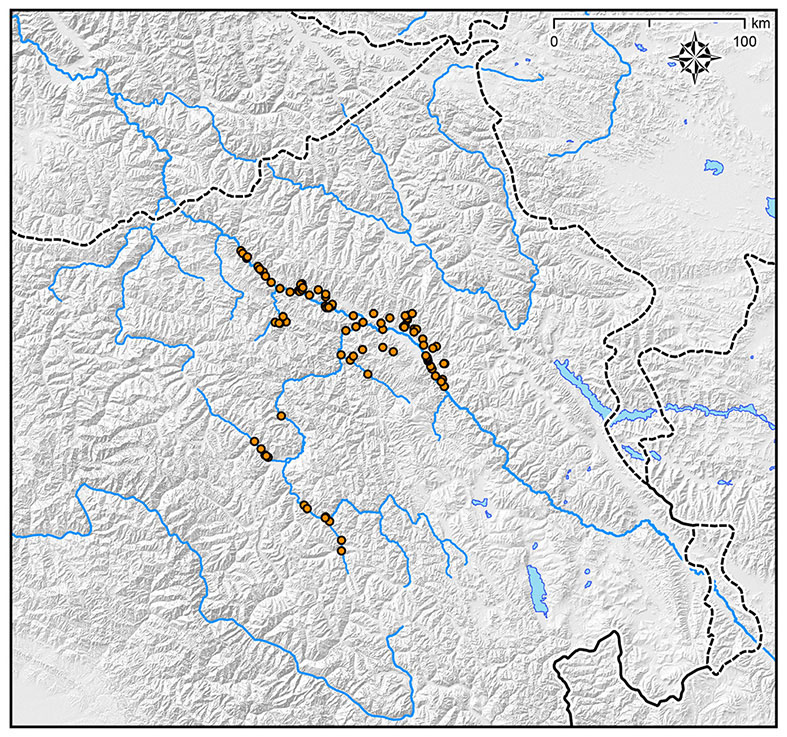
Fig. 3. The 88 sites rock art sites documented by Vernier during his ten-year project.
In the mid-2000s, Vernier was joined in his efforts by Bruneau whilst the latter completed PhD research in the rock art of Ladakh (Bruneau 2010). Her dissertation brought together a corpus of 125 sites, of which thirteen were her discoveries (Fig. 4). The geographical scope of Bruneau’s research was primarily the Indus valley between Dah and Ubshi, Zanskar, and the Siachen valley in Nubra. Using Vernier’s database along with her own, which tallied 4523 carvings (Bruneau 2010, vol. 1, p. 129), Bruneau analyzed the petroglyphs of Ladakh from a statistical perspective, comparing them with those in Central Asia and Tibet, mainly within an interpretative framework constructed by Francfort and his colleagues.
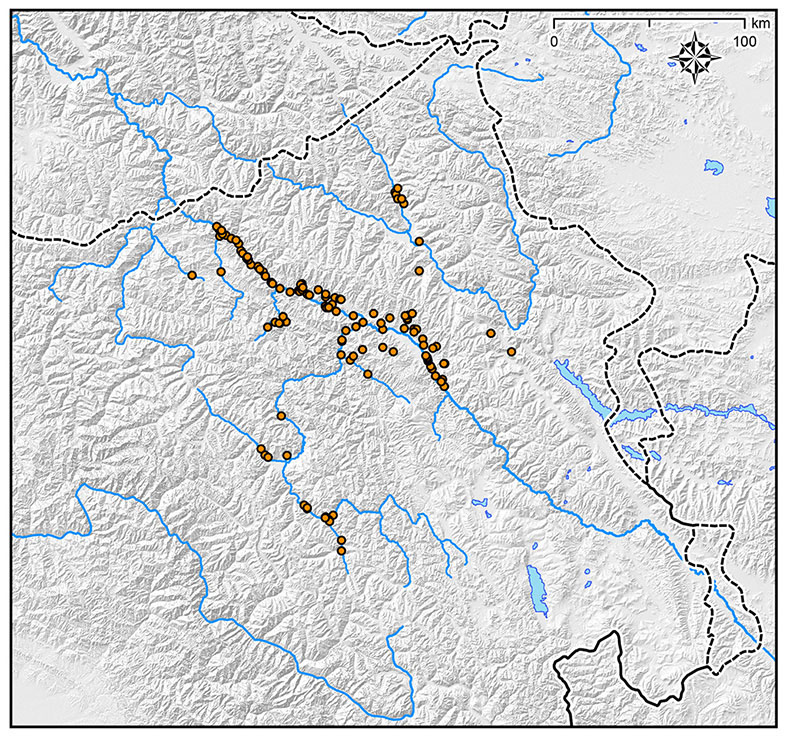
Fig. 4. The 125 rock art sites included in the research corpus of Bruneau for her PhD dissertation.
Parallel to the surveys carried out by Vernier, Ldawa undertook a documentation of rock art of Ladakh in 1997. His preoccupation was more conservation-centered rather than analytical study. As a stakeholder in this millennia-old heritage, he was concerned, and still is more than ever, by the destruction of rock art in the rapid development of the region. He now works with Mehta, who has been actively recording the petroglyphs of Ladakh since 2009, and with Devers, who has been surveying the overall archaeological heritage of Ladakh (fortifications, temple ruins, etc.) since 2009 as well. Together, at an accelerating pace, we have assembled a corpus numbering over 360 sites distributed throughout Ladakh (Fig. 5). Though we have visited every part of the region, there are still isolated villages and side valleys that we were not able to survey yet. However, working as a team, we intend to cover much more ground in the coming years. It is our conviction that numerous rock art sites are still to be found, and that in the short-term the benchmark of 400 sites will easily be crossed, opening the possibility for the documentation of 500 rock art sites in the mid-term.
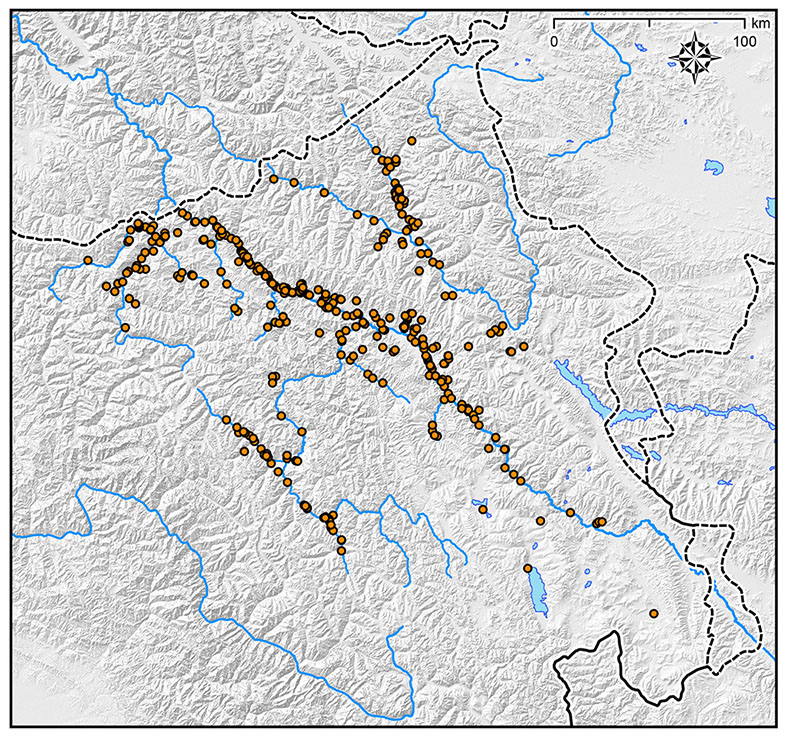
Fig. 5. The 360 rock art sites covered by the corpus created by Ldawa, Mehta and Devers as of Spring, 2017.
Our augmented corpus of rock art opens new perspectives for understanding Ladakh’s past. For example, a clear differentiation between Upper and Lower Ladakh can be observed in the styles of carvings along the Indus valley, and the same holds true for different parts of Purig in Kargil district. Particular motifs can be observed in specific parts of Ladakh and when examined along with surrounding structural remains such as fortifications, a powerful tool to reconstruct the occupation and cultural development of ancient Ladakh is created. These ongoing studies will be the object of forthcoming articles for Flight of the Khyung and other scholarly publications.
It is a matter of deep concern and regret to the authors that the past two decades have witnessed the unprecedented destruction of rock art due to infrastructure expansion and other public and private development activities. Notable rock art sites such as those along the Nimmu-Chilling road and at Alchi Thang, Stakna Zampa, Basgo, Sasoma, Taru Thang, Khaltse, and Zamthang – to mention a few – have been badly affected, with many petroglyphs damaged or annihilated completely. The need of the hour is the protection and conservation of Ladakh’s rock art by raising public awareness and through legislative support.
Bibliography
Bruneau, Laurianne. 2010. Le Ladakh (État de Jammu et Cachemire, Inde) de l’Âge Du Bronze à L’introduction Du Bouddhisme : Une étude de L’art Rupestre. Thesis defended at the Université Paris I Panthéon-Sorbonne under the supervision of H.-P. Francfort.
Conway, William M. 1894. Climbing and Exploration in the Karakoram-Himalayas. London: T. F. Unwin.
Dainelli, Giotto. 1933. Buddhist and Glaciers of Western Tibet. London: Trench and Trubner.
De Terra, Helmut. 1931. “Prehistoric Caves North of the Himalaya.” American Anthropologist, vol. 33, pp. 42–50.
De Filippi, Filippo. 1932. The Italian Expedition to the Himalaya, Karakoram and Eastern Turkestàn, 1913-14. London: Edward Arnold.
Duncan, Jane E. 1906. A Summer Ride Through Western Tibet. London: Smith, Elder and Co.
Director Archaeological Survey of India. 1997. “Jammu and Kashmir, vol. 31 (Exploration in Upper Indus Valley, District Leh).” In Indian Archaeology: A Review 1992-1993, pp. 36–38. Delhi: Archaeological Survey of India.
_____2004. “Jammu and Kashmir (17. Exploration in Ladakh, vol. 18 (Exploration in District Ladakh).” In Indian Archaeology: A Review 1998-1999, pp. 49–59. Delhi: Archaeological Survey of India.
Francfort, Henri-Paul, Daniel Klodzinski, and George Mascle. 1992. “Archaic Petroglyphs of Ladakh and Zanskar.” In Rock Art in the Old World: Papers Presented in Symposium A of the AURA Congress, Darwin (Australia), 1988, vol. 45, pp. 5–27. New Delhi: INGCA.
Francke, August H. 1902. “Notes on rock-carvings from Lower Ladakh.” In Indian Antiquary, vol. 31, p. 398-401.
_____1903. “Some more rock-carvings from Lower Ladakh.” In Indian Antiquary, vol. 32, pp. 361–362.
_____1905a. “Archaeological notes on Balu-mkhar in Western Tibet.” In Indian Antiquary, vol. 34, pp. 203–210.
_____1905b. “The rock inscriptions at Mulbe.” In Indian Antiquary, vol. 34, pp. 72–81.
_____1905-07. “The Dards at Khalatse in Western Tibet.” In Memoirs of the Asiatic Society of Bengal, vol. 1, pp. 413–419.
_____1906a. “Archaeology in Western Tibet. Khalatse: I-Inscriptions at Khalatse; II-Inscriptions at Saspola.” In Indian Antiquary, vol. 35, pp. 237–241; pp. 325–333. Bombay.
_____1906b. “Kleine Erträger einer Missionsreise nach Zanskar.” In Zeitschrift der Deustchen Morgenlandischen Gesellschaft, vol. 60, pp. 645–661. Weisbaden.
_____1907a. “Archaeology in Western Tibet: III-Inscriptions at Basgo and Nyemo, IV-Inscriptions at Daru, V-The Rock inscriptions at Sheh.” In Indian Antiquary, vol. 36, pp. 85–98. Bombay.
_____1907b. “Historische Dokumente von Khalatse in West-Tibet (Ladakh).” In Zeitschrift der Deustchen Morgenlandischen Gesellschaft, vol. 61, p. 583-614.
_____1907c. A History of Western Tibet, One of the Unknown Empires. London: Partridge.
_____1914. Antiquities of Indian Tibet, vol. 1. Personal Narrative. Archaeological survey of India, Calcutta, Superintendent Government Printing (New imperial series, vol. 38).
Neve, Arthur. 1913. Thirty years in Kashmir. London: Edwin Arnold.
Peissel, Michel. 1979. Zanskar: Royaume Oublié Aux Confins Du Tibet. Paris: Robert Laffont.
Roerich, George N. 1931. Trails to Inmost Asia, Five Years with the Roerich Central Asian Expedition. Yale: Yale University Press.
Snellgrove, David L., and Tadeusz Skorupski. 1980. The Cultural Heritage of Ladakh, vol 2: Zanskar and the Cave Temples of Ladakh. Warminster: Aris and Phillips.
Ujfalvy de Mezőkövesd, Károly J. 1884. Aus dem westlichen Himalaya: Erlebnisse und Forschungen. Leipzig: F. A. Brockhaus.
Vernier, Martin. 2007. Exploration et Documentation Des Pétroglyphes Du Ladakh: 1996-2006. Como: Quaderni Fondation Carlo Leone and Mariena Montandon, NodoLibri.
Vohra, Rohit. 1994. “Sogdian Inscriptions from Tangtse in Ladakh.” In Tibetan Studies, Proceedings of the 6th Seminar of the International Association for Tibetan Studies, Fagernes, 1992, edited by Per Kvaerne, 920–29. Oslo: Institute for Comparative Research in Human Culture.
_____1995. “Arabic Inscriptions of the Late First Millenium A.D. from Tangtse in Ladakh.” In Recent Research on Ladakh 4 & 5, Proceedings of the Fourth and Fifth International Colloquia on Ladakh, edited by Henry Osmaston and Philip Denwood, 419–29. London: School of Oriental & African studies, University of London.
_____2005a. Petroglyphs in Purig Area of Ladakh. Vol. V. Himalayan Studies Ladakh Series. Luxembourg: Ethnic Unlimited.
_____2005b. Rock Art in Ladakh. Vol. IV. Himalayan Studies Ladakh Series. Luxembourg: Ethnic Unlimited.
The Prototypic Hunters of the High Plateau: Wild carnivores in the rock art of Upper Tibet – Part 1
Introduction to wild carnivore rock art
This article comprehensively documents wild carnivores in the rock art of Upper Tibet.* Wild carnivores form a distinctive but fairly uncommon subject in the rock art of this vast land. This type of rock art is distributed across the broad tablelands of the Changthang (Byang-thang) but is most numerous in the far western Tibetan region of Tö (Stod). Wild carnivore rock art includes carvings and paintings of tigers, snow leopards, wolves, and possibly bears and foxes. Due to the formidable aura surrounding these potentially dangerous animals, this rock art is particularly gripping and evocative.
Fieldwork for this article was carried out by the author on numerous surveys between 1995 and 2013. Although my survey work has been extensive, this article by no means presents an exhaustive catalog of carnivores in Upper Tibetan rock art. Some wild carnivore rock art not featured in this work has been presented by the Tibetan archaeologist Sonam Wangdu and his Chinese colleagues (Suolang Wangdui 1994), and surely there is more in the sprawling region awaiting discovery.
Suolang Wangdui (Bsod-nams dbang-’dus): 1994. Art of Tibetan Rock Paintings. Introduction by Li Yongxian and Huo Wei. Chengdu: Sichuan People’s Publishing House.
Wild carnivores are portrayed in Upper Tibetan rock art as solitary creatures but also in the act of attacking wild yaks, deer and wild sheep. They sometimes hunt in pairs or less frequently in larger groups. Hunting scenes capture the raw power of a primal impulse in the natural world revolving around survival and sustenance. Nevertheless, wild carnivore rock art was produced in relatively small quantities in Upper Tibet. It is vastly outnumbered by wild herbivores and symbols such as the swastika. For instance, the hunting of wild ungulates (wild yaks, cervids and caprids) by archers on foot and on horseback constitutes one of the most popular genres of ancient rock art in Upper Tibet. While there are many compositions featuring two or more wild ungulates and nothing else, just two scenes depicting more than one wild carnivore without prey have been positively identified in the rock art of the region. There is also a handful of wild carnivores in what appear to be scenes with ritualistic, mythic or symbolic overtones.*
On rock art predation scenes in Upper Tibet and Ladakh, also see Bruneau and Bellezza 2013, pp. 51–53.
Bruneau, Laurianne and Bellezza, John V. 2013: “The Rock Art of Upper Tibet and Ladakh: Inner Asian cultural adaptation, regional differentiation and the ‘Western Tibetan Plateau Style’”, in Revue d’etudes tibétaines, vol. 28, pp. 5–161. Paris: CNRS.
http://himalaya.socanth.cam.ac.uk/collections/journals/ret/pdf/ret_28.pdf
The exact number of carnivores at the seventy-five rock art sites I have surveyed in Upper Tibet is unclear, because anatomical ambiguities impede the identification of some subjects. A tally of readily identifiable wild carnivores indicates that there are at least ninety documented in the rock art of the region. Additionally, there are 30 to 50 or more other animal subjects that may possibly represent wild carnivores, but which could not be positively identified. This indeterminate rock art is too worn, damaged or indistinct in style and execution to attribute to one species or another. The biggest area of ambiguity is potential carnivores and equids, both of which can be portrayed with elongated bodies, pointed ears and long tails. Moreover, there are numerous depictions of carnivores accompanying human hunters in the rock art of Upper Tibet. Although the context of human-animal cooperation favors identification of most of these carnivores as dogs, this is not certain in all cases. As we shall see, there are what might be called prototypic hunting narratives in which human hunters are paralleled by wild animal hunters.
Most notable among wilds carnivore subjects is the striped carnivore, which is probably a portrayal of the tiger (Panthera tigris; Tib: stag). Apart from a very small number of wild ungulates, no other animals with stripes are found in the rock art of Upper Tibet. I have documented fourteen striped carnivores and there may be two or three other examples (see infra, fig. 31).* These ostensible tigers are usually depicted with a long tail curling over the back. They also typically have gaping mouths, lithe bodies and sometimes clawed feet. Striped carnivores are frequently shown attacking prey, a naturalistic setting suggestive of an actual place for the tiger in the ecology of ancient far western Tibet (on this tiger rock art, also see August 2012 and January 2014 Flight of the Khyung). In the rock art of Upper Tibet striped carnivores are shown hunting two types of animals only: wild yaks and deer.† Presumably these were the main prey of the tiger, a big carnivore with a ravenous appetite and the strength to take down large herbivores. The striped variety aside, there are other examples of carnivores with silhouetted or outlined bodies that may denote tigers. These animals are also depicted with long, sinuous tails that extend over the back and lithe bodies, anatomical features more in keeping with feline than canine species. Four apparent tigers have double volute body ornamentation associated with the Eurasian animal style (on this type of rock art, see October and November 2014 Flight of the Khyung).
This number does not include three striped carnivores carved on a rock face at the Rimodong (Ris-mo-gdong) site, a famous rock art composition in the northwestern Tibet district of Ruthok (Ru-thog). See Suolang Wangdui, 1994, p. 67; October 2014 (fig. 27) Flight of the Khyung. These striped carnivores of Rimodong belong to a hunting scene dating to more recent centuries, which is imitative of earlier rock art found on an adjacent stone panel. The much older scene of a striped carnivore pursuing one or more stags has been obscured by the superimposition of a Buddhist mantra (see infra, fig. 42). Five striped carnivores also graced the Luring Nakha (Lu-ring sna-kha) site, in Ruthok. However, these rock carvings appear to have been destroyed by a road construction project. For photographs of this rock art, see Suolang Wangdui 1994, pp. 52–54, 56.
In an origins myth of the world found in an Old Tibetan funerary ritual text called Sha ru shul ston rabs (written ca. 850–1000 CE), reference is made to a tiger and yak joined in combat. See January 2014 Flight of the Khyung. The Zhang Zhung language of ancient western Tibet appears to have had its own word for the ‘tiger’: la-ram/la-he, possibly related to Tungusic terms (Martin 2010: 209, 210).
Martin, Dan. 2010. “Zhangzhung Dictionary” in Revue d’Etudes Tibétaines, No. 18, April, 2010, pp. 33–253. Paris: CNRS. http://himalaya/socanth.cam.ac.uk/collections/journals/ret/pdf/ret_18_02.pdf
I have recorded three examples of felines with distinctive spots in Upper Tibetan rock art, signaling that they are probably depictions of the snow leopard (Panthera uncia; Tib: gsa’). In contemporary Upper Tibet, the snow leopard is the largest native feline species. The common leopard (Panthera pardus; Tib: gzig) is not found in that part of the Tibetan Plateau (but it ranges in the southeastern portion, as does the clouded leopard; Tib: gung). Two portrayals of spotted carnivores occur in graphic hunting scenes. The third example is depicted in conjunction with a wild ungulate in an aspect that does not appear to be indicative of an impending attack. Instead, this composition may embody wider symbolic significance connected to the predator-prey cycle. There are several examples of carnivore petroglyphs carved to produce a stippled effect, but it is not clear if this was meant to represent spots or other kinds of fur patterns.
It is possible that the Tibetan subspecies of the Eurasian lynx (Lynx lynx isabellinus; Tib: dbyi) may be represented in the rock art of Upper Tibet, as this predator is quite common in mountainous areas of the region. However, no definitive evidence for this bob-tailed, tuft-eared predator has been found in Upper Tibetan rock art. If certain subjects were carved or painted as facsimiles of the Tibetan lynx, they are so vague in form as to be virtually unidentifiable. Similarly, no Upper Tibetan rock art confidently identified as portraying the lion made prior to 1000 CE has come to light (for a carved Buddhist example, see July 2014 Flight of the Khyung). Although the lion emerged as an important symbol of political might and as a royal symbol associated with Buddhism in the Tibetan Imperial period (ca. 650–850 CE), there are far fewer signs of its significance in the prehistoric epoch (pre-650 CE).*
Copper alloy talismans, insignia and horse tack featuring lions proliferated greatly in the Imperial period, but this subject is not well represented in earlier variants of copper alloy objects. I base this observation on my surveys of many collections of small copper alloy objects known as thokcha. For two examples assigned to the Imperial period, see March 2011 (figs. 19, 20) and October 2010 (fig. 2) Flight of the Khyung. H. E. Richardson (1998: 227) notes that the famous lion sculpture of the Imperial period at the royal burial ground of ’Phyong-rgyas can probably be traced to Persia. For a photograph of this sculpture, see March 2011 Flight of the Khyung. Bussagli (1949: 333) similarly holds that the symbolism of the lion apparently spread from Iran to Tibet. While this vector of geographic transmission appears to have considerable validity, the existence of Tibetan copper alloy objects with lion motifs that appear to predate the Imperial period indicates that it was also known in the prehistoric epoch. For example, see the pair on a ceremonial fibula in Bellezza 2013, p. 97.
Bellezza, John V. 2013: Death and Beyond in Ancient Tibet: Archaic Concepts and Practices in a Thousand-Year-Old Illuminated Funerary Manuscript and Old Tibetan Funerary Documents of Gathang Bumpa and Dunhuang. Philosophisch-Historische Klasse Denkschriften, vol. 454. Wien: Verlag der Österreichischen Akademie der Wissenschaften.
Bussagli, Mario. 1949: “Bronze objects collected by Prof. G. Tucci in Tibet: A Short Survey of Religious and Magic Symbolism”, in Artibus Asiae, vol. 12 (no. 4), pp. 331–347. Ascona.
Richardson, H.E. 1998. High Peaks, Pure Earth: Collected Writings on Tibetan History and Culture. London: Serindia Publications.
The most common wild predator in Upper Tibet is the Tibetan wolf (Canis lupus filchneri; Tib. Spyang-kyi), which differs taxonomically and genetically from other grey wolf subspecies in still not fully understood ways. The sheer number of wolves populating Upper Tibet might suggest that this animal would be a relatively popular subject in wild carnivore rock art, but this is difficult to confirm from the pictorial evidence. Ideally, morphological traits related to body, head, leg shape, and movement could better determine which taxa a carnivore belongs. However, the reproduction of these traits in Upper Tibetan rock art is seldom sufficiently detailed to make a definitive identification. It might be expected that carnivores with more pointed muzzles and straighter tails pointing downward are depictions of wolves, but these anatomical details alone may be misleading. Felines can assume a similar tail position, and in the absence of other clearly delineated anatomical traits, some such rock art examples may be felids rather than canids.*
For a carnivore of uncertain identity, see Suolang Wangdui 1994, p. 110.
The depiction of the Tibetan blue bear (Ursus arctos pruinosus; Tib: dred-mong), a subspecies of the brown bear, appears to be rare in the rock art of Upper Tibet. There are only three or four red ochre pictographs of thickly set carnivores that may possibly be facsimiles of this largest meat-eating mammal in Upper Tibet. This rock art is all located in the Eastern Changthang.
It is not known if the Tibetan fox (Vulpes ferrilata; Tib: wa) appears in the rock art of Upper Tibet. There is however a single red ochre pictograph in the Eastern Changthang that depicts a carnivore with a big bushy tail, recalling the fox. The fox was not traditionally accorded a high status in Tibet, which may help to explain its absence from the rock art record.
Questions of meaning and function in wild carnivore rock art
The rock art of Upper Tibet was produced over a period of two millennia or longer by a great variety of individuals. It is therefore not feasible to assign singular definitions of meaning or assume that this rock art served a specific set of functions. This is particularly true of subjects and compositions with a wide spatial and temporal purview. As demonstrated for the swastika (May and June 2016 Flight of the Khyung), wild yak hunting rock art (July, August, September 2016 Flight of the Khyung) and wild yak portraits (April, May, June 2017 Flight of the Khyung), etc., the meaning and function of wild carnivore rock art is probably best seen as transmutable and possibly even negotiable.
The significance of rock art is liable to have varied over time, in step with cultural and technological developments in Upper Tibet. Social factors such as vocation, rank and gender may also have affected how rock art was perceived even within a single period. The personal proclivities, motivations and circumstances of artists potentially had a deep impact on how rock art was originally regarded as well. Moreover, makers, viewers and users of rock art may have conceived of its meaning and function in differing terms.
In my estimation, theories of meaning and function based on more abstract paradigms of understanding such as cognitive, epistemological and semiotic approaches are of limited utility in assessing Tibetan rock art, as they do not lend themselves to empirical verification. These intellectual approaches are also far removed from the cultural, historical and linguistic factors that underpinned rock art production. In previous newsletters and print publications, I have correlated rock art to archaeological monuments, objects and processes, a productive approach to tackling questions of meaning and function. Nevertheless, parallels drawn between rock art and other archaeological resources yield a range of hypotheses on which to discriminate its original usage and value.
Wild carnivore rock art is concentrated in far western Tibet, where the greatest number of sites in Upper Tibet have been documented. Nearly three-quarters of all identifiable wild carnivore subjects including all but one striped feline subjects are found in Guge and Ruthok, two districts in far western Tibet (presently, two counties of the Tibet Autonomous Region). These two areas of the far west still have a mixed agro-pastoralist subsistence economy (modern economic changes of the last fifty years notwithstanding). The many tracts of abandoned farmland in Guge and Ruthok attest to a more highly developed agrarian way of life in the past. Archaeological evidence suggests that a mixed economy supported the inhabitants of the region for the last 2000 or 3000 years (see February 2015 Flight of the Khyung), encompassing the main era of rock art production (Late Bronze Age, Iron Age and Protohistoric period). However, rock art sites in far western Tibet are situated 3–30 km from agricultural lands (viable or defunct), in areas that were traditionally used for herding livestock and for hunting. This locational data, as well as the contents of rock art, indicate that its makers were chiefly engaged in non-agricultural pursuits. Thus, rock artists may have had specialized vocational or ceremonial functions as hunters and pastoralists. At rock art sites on the Changthang, wild carnivore art occurs in pastoral and venatic environments farther removed from agricultural enclaves.
Wild carnivores make up approximately 1–2% of all zoomorphic subjects in the rock art of Upper Tibet.* Although wild carnivores played a prominent role in the cultural affairs of ancient Tibet, their significance pales in comparison to the wild yak. The wild yak and especially the domestic yak have long been the lynchpin of the Upper Tibet economy, going some way in explaining why they are by far the most common zoomorphic subject in the rock art of the region. Wild yak and other wild ungulate (cervids and caprids) portraits and hunting scenes with humans abound, highlighting the cultural, religious and social importance of these animals as well.
Similarly, tigers are not a common zoomorphic subject in Tibetan copper alloy objects (thog-lcags) of both the prehistoric and historic eras. For examples, including a tiger attack scene, see December 2010 (figs. 10, 11), August 2012 (fig. 11) and February 2016 (figs. 1–4) Flight of the Khyung. Also see Bruneau and Bellezza 2013, p. 143 (fig. V.23).
As hunters seemed to have had a big role in creating rock art in Upper Tibet, it might be speculated that they resisted fashioning simulacra of wild carnivores to minimize hunting competition; these likenesses perceived as having sympathetic magic properties. In a similar vein, invoking wild carnivores may have been thought of as a dangerous or provocative act. Another factor that may possibly explain why wild ungulates far outnumber wild carnivores in the rock art of Upper Tibet is the paucity of patently ritual and magical compositions. As we know from literary accounts, wild carnivores are often associated with priests, deities, warriors, and rituals in the Tibetan cultural world of the last 1200 years, themes that appear to form a small percentage of the total number of rock art compositions in Upper Tibet.
On the western fringe regions of the Tibetan Plateau, wild carnivores constitute a larger percentage of total zoomorphic subjects in rock art. According to a rock art survey conducted by Bruneau, wild canids and felids make up approximately 6% of all rock art subjects in Ladakh (Bruneau and Bellezza 2013: 27, 28). However, this percentage may be inflated by the categorization of animals with vaguer anatomical traits as wild carnivores. In the rock art of Spiti, wild carnivores outnumber wild yak, deer and bird subjects, making up around 3–4% of all zoomorphic imagery (cf. July 2015 Flight of the Khyung). A review of publications on the rock art of north Inner Asia (Mongolia, Pamirs, Kazakhstan, South Siberia, etc.) also indicates that wild carnivores are generally more predominant there than in Upper Tibet. Nevertheless, in most territories of Inner Asia, wild ungulates far exceed wild carnivores (felines, wolves, bears, etc.) as a share of zoomorphic rock art. Trans-cultural factors help account for the large proportion of wild ungulates at rock art sites throughout Inner Asia. Like Upper Tibet, hunting as a subsistence activity, social status building exercise and ceremonial gesture appears to be a major factor in explaining the predominance of wild ungulate rock art in the broader Inner Asian context.
Although wild carnivore art comprises a small set of rock art in Upper Tibet, it vividly illustrates ecological patterns connected to the predator-prey cycle. Wolves, snow leopards, lynxes, blue bears, foxes, and presumably once tigers rely on hunting for their survival (foxes also scavenge and bears forage). Wild carnivores chasing wild yaks, deer and wild caprids eloquently sums up this fact of life. There are however no overt scenes of wild carnivores attacking humans in the rock art of Upper Tibet. While such attacks must have been a risk, no effort was made to acknowledge it in rock carvings and paintings. This might possibly be accounted for by a reluctance to avoid registering misfortune in a material form or to symbolically court trouble with other beings of the cosmos.
Much rock art in Upper Tibet extols the exuberance of life and the great animal actors who share their existence with human inhabitants. These kinds of scenes record momentous events and cultural expressions of a positive or triumphant character. Specifically, through the medium of wild carnivore rock art, makers expressed exhilaration, aggression, strength, bravery, and other strident emotions connected to males and their realm of activities. For example, scenes depicting wild carnivores tearing apart their prey next to chariots and armed individuals seem to articulate martial sentiments and practices.
Tibetan ritual literature, a 1200-year-old tradition, is replete with expositions of the origins and functions of a wide variety of beliefs, customs and rituals (smrang). By furnishing a temporal and biographical source, etiologic myths legitimize and raise the value and stature of religious ideas and practices. Pronouncing the origins of things was regarded as vital when performing critical functions like rites that cure the sick or guide the dead. As noted, the great proliferation of hunting rock art indicates that hunting was a key component of the ancient economy, society and culture of Upper Tibet. Drawing parallels from ritual literature, perhaps some older rock art scenes depicting wild carnivores attacking wild ungulates served as a prototype or model for hunting by humans. Seen in this manner, any such composition records human hunters emulating or being inspired by wild carnivores carrying out instinctual activities. Perhaps before the advent of writing in Tibet, certain wild carnivore hunting scenes may have functioned as graphic equivalents of the ubiquitous written and oral traditions of furnishing a pedigree for cultural activities and materials. Based on etiologic myths in textual and ethnographic records, we might further consider that wild carnivore attack scenes were perceived as empowering human hunters, elevating the importance and prestige of their activities by placing them in a wider historical or cosmological ambit.
The application of Tibetan textual and ethnographic sources to central questions of meaning and function in wild carnivore rock art yields several other hypotheses worthy of consideration. Employing textual indications is a particularly fruitful approach when historical sources appear to stem from the same cultural and temporal wellspring as the rock art itself. An article in the June 2017 Flight of the Khyung explores the methods and theory behind using Old Tibetan texts for a better understanding of ancient mortuary structures, objects and procedures on the Tibetan Plateau. Pursuant to that discussion of textual relevance, is a review herein of what Tibetan literature might more tell us about wild carnivore rock art.
In this review of the significance of wild carnivore rock art in Upper Tibet the focus is on the tiger. However, much of what is observed for this species is applicable to other wild felines, wolves and bears. In the Tibetan cultural world, these types of creatures are what might be described as power animals. Their basic qualities of ferocity, brute strength and awesome appearance are largely interchangeable in Tibetan beliefs, myths, rituals, and customs.
The cultural role of the tiger in Tibetan textual and ethnographic sources comprises a wide spectrum of practices and beliefs. This material is particularly germane as a cultural-historical backdrop to Upper Tibetan wild carnivore rock art of the Early Historic period. It is difficult, however, to relate specific traditions recorded in textual and ethnographic sources to individual tiger rock art compositions, for there are no independent means available to ensure the accuracy of attributions made. Correspondences between rock art, texts and ethnography are therefore best drawn in general and non-binding terms.
Complications arising from an attempt to apply textual and ethnographic materials to an interpretation of the prehistoric era are greatly magnified. Cultural and technological developments that transpired in the historic era render comparisons to earlier rock art inconclusive and even irrelevant in some cases. Nevertheless, to deny any cultural links between the Tibetan literary tradition and the pre-7th century CE era is tantamount to holding that Tibet of the Early Historic period sprung out of a vacuum or from an entirely foreign milieu, both scenarios of which are untenable. Textual materials commonly refer to a prehistoric past, albeit one that it is not well historicized. Similarly, long-term historical continuities are supported by archaeological evidence, burial, architectural and artistic traditions that can be traced from remote periods to the historic era (eg., mortuary mounds/caprid inhumation, herringbone masonry courses/hewn alcoves, horned eagle/wild yak rock art). That there is a Tibetan cultural legacy of longstanding status, however, does little to pinpoint which textual or folk traditions are relevant to specific examples of prehistoric tiger rock art. Bereft of direct instruments of comparison, we are left with a handful of broad themes that potentially aid in analyzing the creation and usage of tiger rock art, none of which are independently verifiable.
In the August 2012 Flight of the Khyung, I furnish a synopsis of the place of the tiger in Tibetan ritual texts, focusing on Classical Tibetan accounts in Yundrung Bon. Taken together, the various functions of the tiger enumerated illustrate how deeply anchored this animal is in the cultural history of Tibet. This is borne out by the many old place names and personal names in Tibet that carry the word tiger. The awesome qualities of tigers are extolled in the Gesar Epic and in folksongs across Tibet, another indication of this animal’s key role in the imagination of Tibetans down to the present day. According to Yungdrung Bon ritual texts, from prehistoric times until the reign of King Trisong Deutsen (Khri-srong lde’u-btsan, 755–797 CE), high priests and adepts used hats and robes trimmed in tiger skin as status symbols, insignia of great accomplishment and badges of courage. Vestiges of this tradition are still visible today in the sartorial customs of Tibetans. Some priests and sages are recorded as magically manifesting as tigers to carry out ritual work and esoteric practices. Likewise, some spirit-mediums in today’s Upper Tibet rely upon helping spirits in the form of tigers to help cure human and livestock diseases and eliminate other types of misfortune, acting the part of growling and springing tigers. In Tibetan literature, tiger skin costumes and accoutrements such as the quiver were symbols of the male warrior, and epithets for the warrior often include the Tibetan word for tiger (stag). These customs were evident up to modern times. Similarly, a variety of male protective and tutelary deities in Buddhism and Yungdrung Bon are clad in tiger skins, possess physical qualities of tigers, ride on tigers, and have tigers in their retinues. Moreover, tiger skin and edible sculptures of tigers are used in a variety of rituals.
A comparable but somewhat narrower range of themes and functions for the tiger are documented in Old Tibetan literature, written between circa 750 CE to 1000 CE. The Old Tibetan texts that concern us most have a non-Lamaist religious character, making no reference to the Buddhist religion. In many crucial areas, the tenor and bearing of the tiger in this older genre of literature match Classical Tibetan accounts. The most common occurrence of ‘tiger’ in the Dunhuang manuscripts is as an element of personal names of ministers and other high ranking personalities.*
A search of texts on the Old Tibetan Documents online website is revealing: http://otdo.aa.tufs.ac.jp/.
One of the earliest and most revealing examples of a divinity with tigerish qualities is found in the Dunhuang text ITJ 731, probably written prior to the 10th century CE (Bellezza 2008: 514–517).* In this harrowing tale of murder, a young shepherdess is rescued by Small Tiger Bumblebee (Bong-bu stag-cung) of the meadow, the exterminator of homicidal demons known as sri. In another Dunhuang manuscript of ca. late 8th or 9th century CE, Pt 126, among elaborate instructions for propitiating personal protective deities (sku-bla), the lord of the Dmu (an archetypal Tibetan lineage) stipulates the offering of many tigers, leopards, black bears and brown bears. While ancient garments such as the skin robe (slag) are mentioned in the Dunhuang manuscripts, I have not located specific references to tiger-skin costumery. Nevertheless, the Gathang Bumpa manuscripts (composed ca. 850–1000 CE) note several deities attired in tiger skin robes (stag kyi slag-pa/stag kyĭ thul-pa’) and hats (stag–zhu). In the Old Tibetan Chronicle and ITJ 506, the brave are awarded a symbol of valor in the form of a tiger or made from a tiger body part (Stein 2010: 98, 99).† The bravery of the warrior synonymous with the tiger is also documented in Pt 1290 (ibid. 103, 105).‡
Bellezza, John, V. 2008: Zhang Zhung: Foundations of Civilization in Tibet. A Historical and Ethnoarchaeological Study of the Monuments, Rock Art, Texts and Oral Tradition of the Ancient Tibetan Upland. Philosophisch-Historische Klasse Denkschriften, vol. 368. Wien: Verlag der Österreichischen Akademie der Wissenschaften.
Stein, R. A. 2010: Rolf Stein’s Tibetica Antiqua (trans. & ed. A. P. McKeowen). Brill’s Tibetan Studies Library, vol. 24. Leiden: Brill.
Chinese sources note that the camp of the 41st king of Tibet Ralpachen (Ral-pa can; reigned 815–841 CE) was decorated with golden figures of tigers, leopards, dragons and lizards (Richardson 1998: 228, after Bushell 1880). The T’ang Annals record that red-colored shrines erected on the burial mounds of great warriors in northeastern Tibet had white tigers painted on them (ibid. 230, 272; Stein 1972: 201; Stein 2010: 98). According to Stein (2010: 98), these painted tigers served as an emblem of bravery extolling the deeds of the deceased.
Richardson, H. E. 1998. High Peaks, Pure Earth. Collected Writings on Tibetan History and Culture. London: Serindia Publications.
Stein, R. A. 1972. Tibetan Civilization (trans. J. E. S. Driver). Stanford: Stanford University Press.
In summary, the major historical and cultural themes in Tibet concerning the tiger include the following:
- The tiger as a symbol of bravery synonymous with the warrior.
- Tiger skin as a political emblem of distinction for male personalities.
- Divine manifestations in the form of the tiger.
- The tiger as a soul receptacle and clan symbol.
- Body parts and facsimiles of the tiger as objects in rituals (possibly including funerary, curative, magical, and divinatory types, etc.).
As a departure point for understanding the ideological background of Upper Tibetan rock art, it is these kinds of leitmotifs that may be potentially applied to an interpretation of felid rock art in Upper Tibet, provided the caveats detailed above are factored into any hypothetical assignment of meaning and function.
Dating of Rock Art
The chronology suggested herein contains estimates based on a variety of benchmarks and inductive means of analysis. The attributions thus formulated, however, have not undergone chronometric verification. The chronology offered should only be viewed as presenting plausible indicators of age, as it is based on a subjective assessment of the empirical evidence and inferences drawn from a wide range of collateral materials. The criteria used to assess the age of rock art include stylistic and thematic categorization, survey of general characteristics of site contents, historical and ethnographic analysis, cross-cultural comparison, application of associative archaeological data, gauging environmental cues, examination of techniques of production, determination of the sequence of superimpositions, and inspection of the erosion and re-patination of petroglyphs and the browning and ablation of pictographs.
The chronological attributions used in this work are as follows:
Prehistoric epoch
Late Bronze Age: circa 1200–700 BCE (differential dating of Late Bronze Age and Early Iron Age omitted due to lack of data)
Iron Age: ca. 700–100 BCE
Protohistoric period: ca. 100 BCE to 650 CE
Historic epoch
Early Historic period: ca. 650–1000 CE
Vestigial period: ca. 1000–1300 CE
Later Historic period: ca. 1300–1950 CE
Gallery of Images
This gallery is divided into five groups of rock art:
- Solitary wild carnivores
- Multiple wild carnivores without other figures
- Possible wild carnivores
- Wild carnivores hunting wild ungulates
- Wild carnivores in ostensible ritual, mythic and symbolic scenes
Note: Groups 4 and 5 are found in next month’s Flight of the Khyung.
Note: The wild carnivore petroglyphs and pictographs illustrated in this article, like most zoomorphic figures in the rock art of Upper Tibet, are between 5 cm and 50 cm in length. Dimensions of figures obtained in the field were not tabulated for this article.
Group 1: Solitary wild carnivores
This group of wild carnivore rock art consists of animals depicted without any other figures save for minor additions to the rock surface. These petroglyphs and pictographs are stylistically, technically and chronologically diverse.
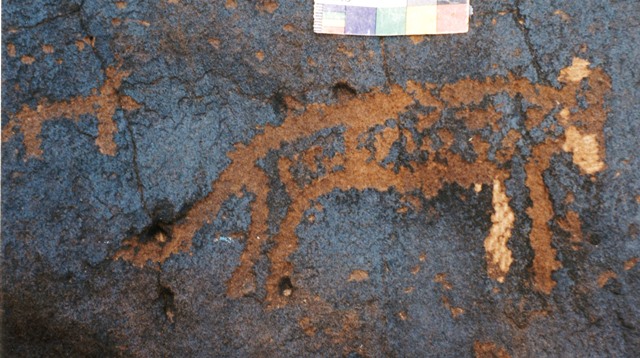
Fig. 1. Wild carnivore with small quadruped above that may form an integral composition
Taxa: probable feline
Prominent motifs: arched back; downward pointing tail; two long, upright ears; pointed muzzle; four unflexed legs
Body treatment: with lines and spots, probably simulating stripes or spots
Technique: moderately carved
Region: Western Changthang
Estimated Age: Iron Age
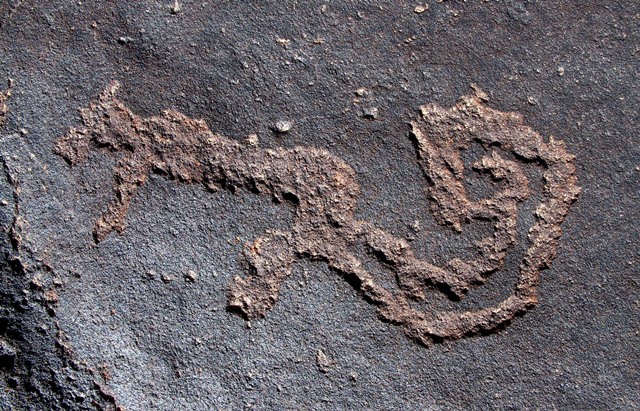
Fig. 2. Wild carnivore
Taxa: feline
Prominent motifs: double curved back; thick, upward pointing tail, spiral at end; upright ear; squared muzzle; two unflexed legs
Body treatment: partially silhouetted
Technique: deeply carved
Region: Western Changthang
Estimated Age: Late Bronze Age or Iron Age
Additional details: Situated on same boulder as fig. 37. It may have been carved along with other figures, a chariot among them.
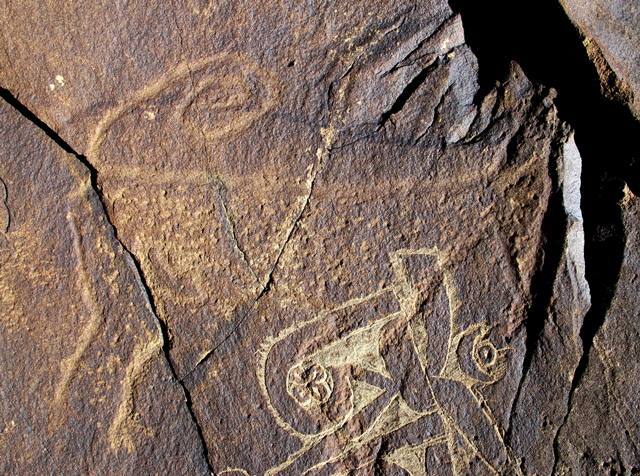
Fig. 3. Wild carnivore, front portion damaged
Taxa: feline, possible snow leopard
Prominent motifs: concave back; tail overarching back, spiral at end; two flexed rear legs with clawed feet, one flexed front leg
Body: pecked, probably simulating spots
Technique: moderately carved
Region: Far Western Tibet
Estimated Age: Iron Age
Additional details: Buddhist mani mantra superimposed on anterior portion of figure.
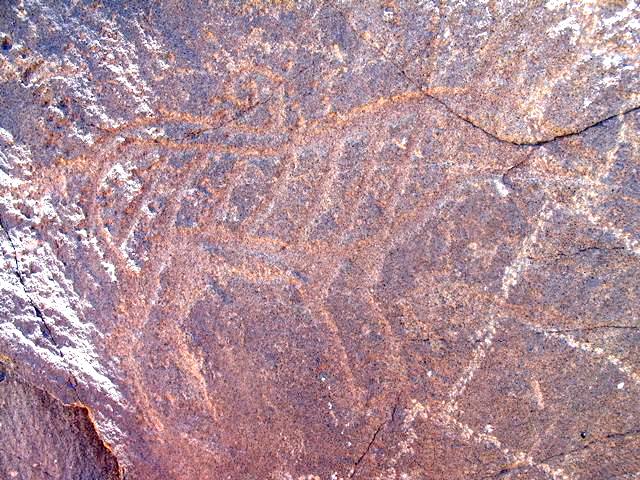
Fig. 4. Wild carnivore
Taxa: probable tiger
Prominent motifs: double curved back; tail overarching back, spiral at end; upright ear; gaping mouth; four flexed legs
Body: lined, probably simulating stripes
Technique: moderately carved
Region: Far Western Tibet
Estimated Age: Iron Age
Additional details: Tiered shrine superimposed on anterior portion of head. Also see August 2012 (fig. 5) and November 2014 (fig. 4) Flight of the Khyung.
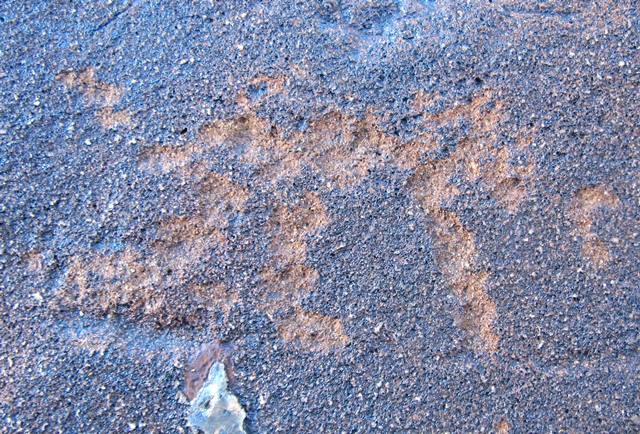
Fig. 5. Wild carnivore
Taxa: feline or canine
Prominent motifs: double curved back; V-shaped tail; squared muzzle; three flexed legs
Body: silhouetted
Technique: moderately carved
Region: Far Western Tibet
Estimated Age: Iron Age
Additional details: Carved on boulder with wild yaks, stag and other figures, representing several different compositions.
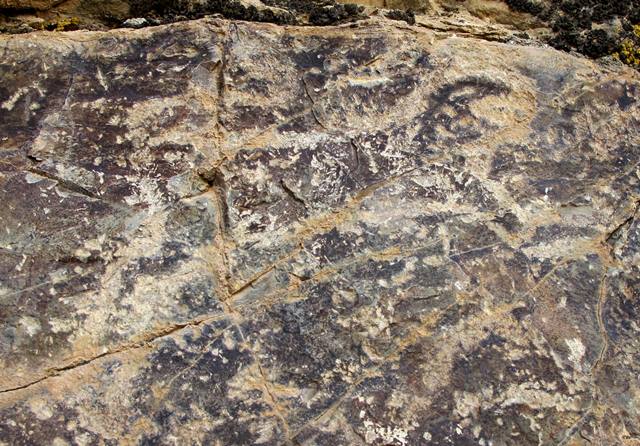
Fig. 6. Wild carnivore, running or leaping
Taxa: feline
Prominent motifs: concave back; S-shaped tail overarching back, curled at end; gaping mouth; three flexed legs
Body: outlined
Technique: moderately carved
Region: Far Western Tibet
Estimated Age: Iron Age
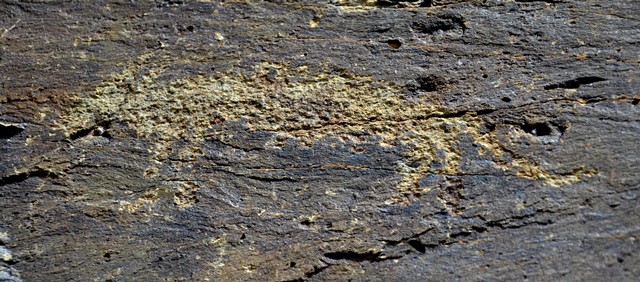
Fig. 7. Wild carnivore
Taxa: possibly wolf
Prominent motifs: arched back; downward pointing tail, slightly curled at end; upright ears; squared muzzle; four flexed/unflexed legs
Body: silhouetted
Technique: moderately carved
Region: Far Western Tibet
Estimated Age: Protohistoric period
Additional details: Wild yak and stag on same stone panel forming separate compositions.
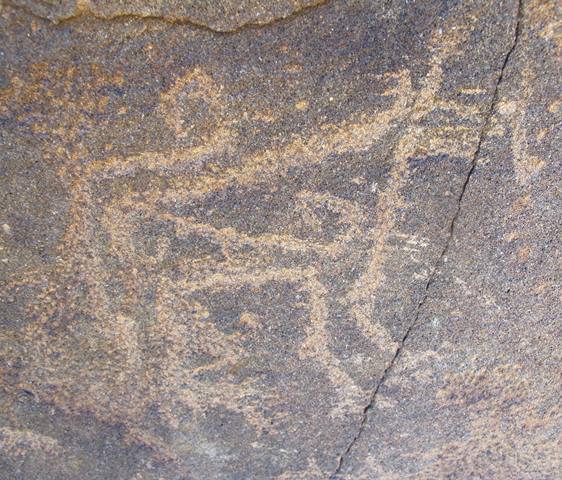
Fig. 8. Wild carnivore
Taxa: feline
Prominent motifs: straight back; tail overarching back, spiral at end; upright ears; gaping mouth; four flexed legs with clawed feet
Body: double volute motif
Technique: moderately carved
Region: Far Western Tibet
Estimated Age: Iron Age of Protohistoric period
Additional details: Two wild yaks in close proximity forming separate composition. Also see November 2014 (fig. 65) Flight of the Khyung.
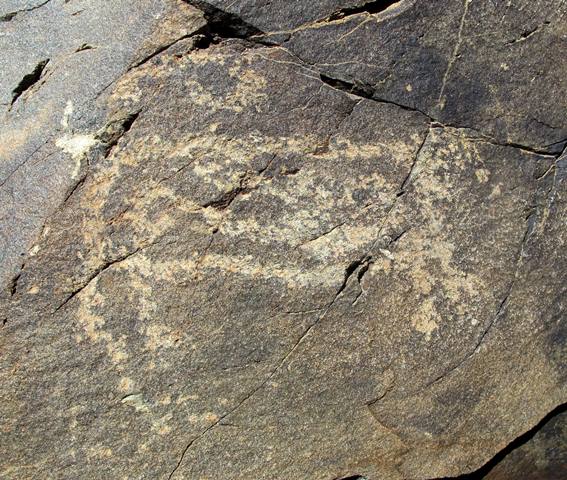
Fig. 9. Wild carnivore
Taxa: feline
Prominent motifs: straight back; tail overarching back, curled at end; gaping mouth; four flexed legs
Body: double volute motif
Technique: lightly carved
Region: Far Western Tibet
Estimated Age: Iron Age or Protohistoric period
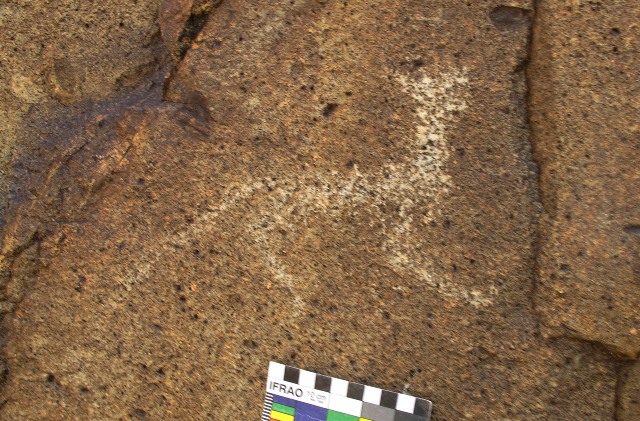
Fig. 10. Wild carnivore
Taxa: feline or canine
Prominent motifs: straight back; downward pointing tail; upright ear; gaping mouth; two flexed legs
Body: silhouetted
Technique: lightly carved
Region: Western Changthang
Estimated Age: Protohistoric period
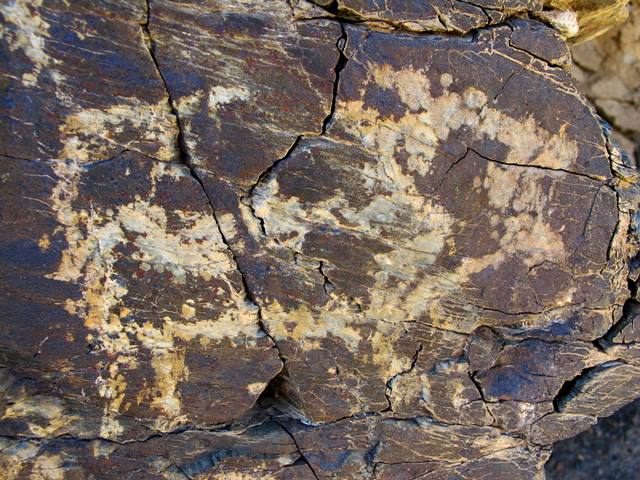
Fig. 11. Carnivore
Taxa: feline or canine
Prominent motifs: straight back; L-shaped tail overarching back; upright ears; gaping mouth; four unflexed legs
Body: outlined
Technique: moderately carved
Region: Far Western Tibet
Estimated Age: Early Historic period
Additional details: This figure may possibly be a prototypic wild carnivore or dog. It is located on edge of stone panel facing away from mounted and standing human figures pursuing yaks (wild?), all of which probably form an integral scene.
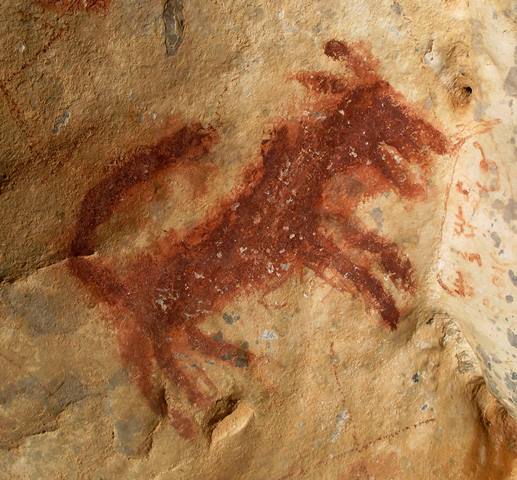
Fig. 12. Wild carnivore
Taxa: feline or canine
Prominent motifs: concave back; L-shaped tail overarching back; upright ears; gaping mouth; four unflexed/flexed legs, male sexual organ
Body: silhouetted
Technique: painted, red ochre
Region: Eastern Changthang
Estimated Age: Protohistoric period or Early Historic period
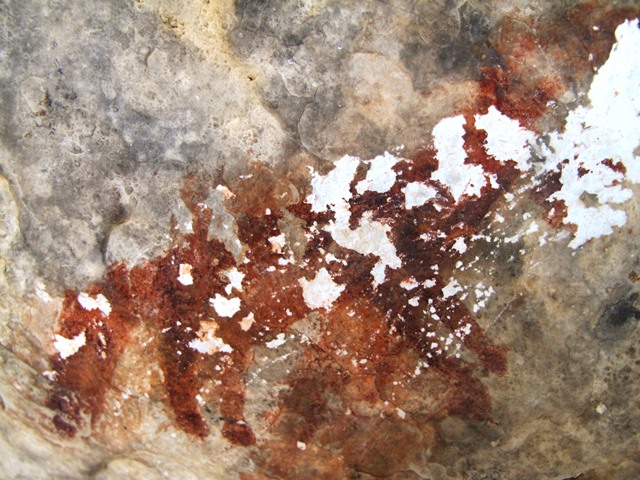
Fig. 13. Wild carnivore, partially damaged
Taxa: possibly wolf or fox
Prominent motifs: arched back; downward pointing busy tail; upright ears; four unflexed legs
Body: silhouetted
Technique: painted, red ochre
Region: Eastern Changthang
Estimated Age: Protohistoric period or Early Historic period
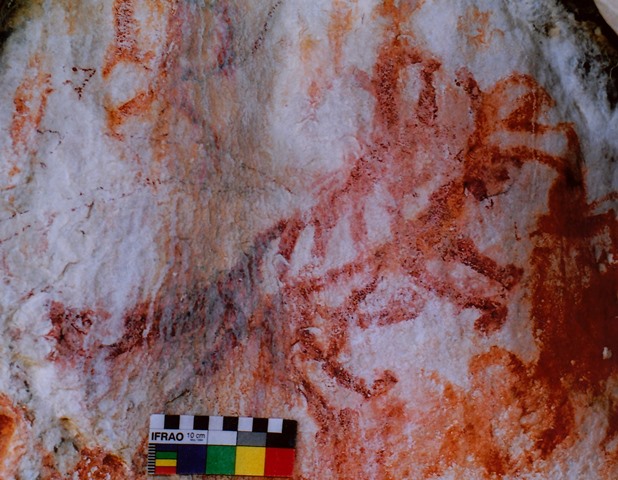
Fig. 14. Wild carnivore
Taxa: feline
Prominent motifs: double curved back; downward pointing tail, curled at end; upright ear; gaping mouth; four unflexed legs, possible male sexual organ
Body: lined, probably simulating stripes
Technique: painted, red ochre
Region: Eastern Changthang
Estimated Age: Early Historic period or Vestigial period
Additional details: Gaping mouth may possibly have been added to pictograph at later date.
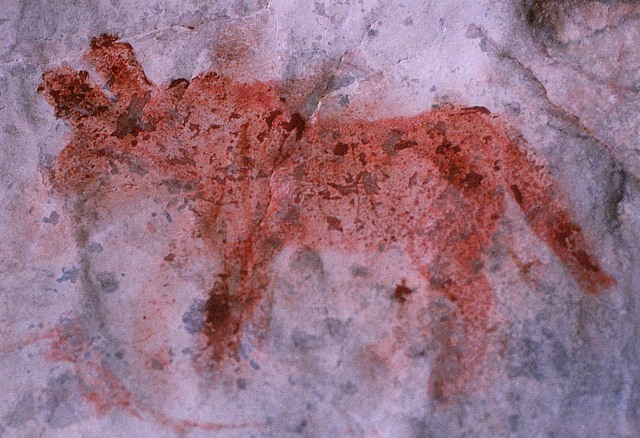
Fig. 15. Wild carnivore
Taxa: possibly blue bear
Prominent motifs: anterior hump, flat back; downward pointing tail; upright ears; squared muzzle; two flexed/unflexed legs
Body: silhouetted
Technique: painted, red ochre
Region: Eastern Changthang
Estimated Age: Early Historic period or Vestigial period
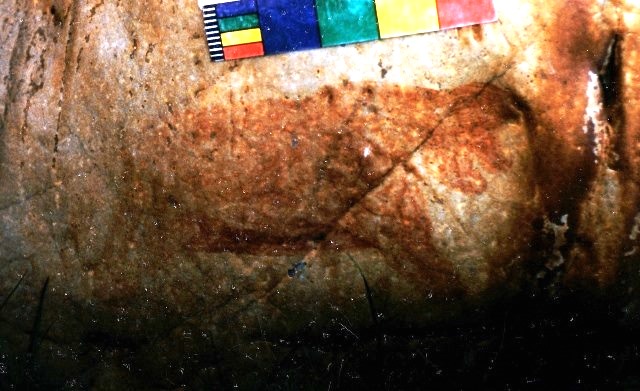
Fig. 16. Wild carnivore
Taxa: possibly blue bear
Prominent motifs: flat back; downward pointing tail, curled at end; upright ear; gaping mouth; two unflexed legs
Body: silhouetted
Technique: painted, red ochre
Region: Eastern Changthang
Estimated Age: Early Historic period or Vestigial period
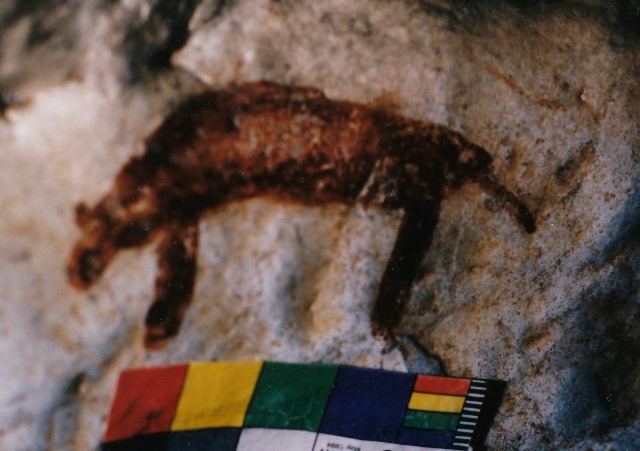
Fig. 17. Wild carnivore
Taxa: possibly blue bear
Prominent motifs: arched back; downward pointing tail; upright ear; rounded muzzle; two unflexed legs
Body: silhouetted
Technique: painted, red ochre
Region: Eastern Changthang
Estimated Age: Protohistoric period or Early Historic period
Group 2: Multiple wild carnivores without other figures
This group contains just two scenes of two and three wild carnivores respectively, each depicted without other figures. The figures in each composition are closely matched in terms of style and aspect.
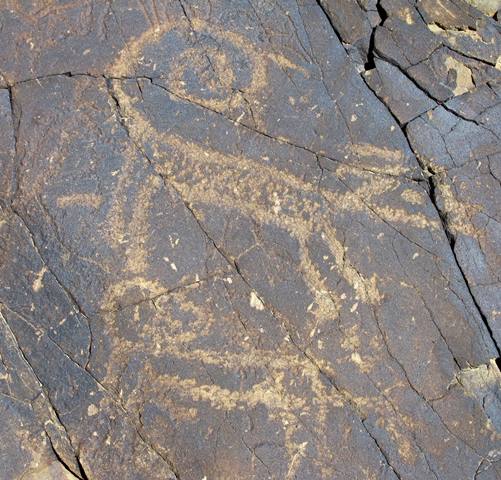
Fig. 18. Pair of wild carnivores
Taxa: feline
Prominent motifs: flat back; tail overarching back, spiral at end; upright ears; eye; triangular/elongated muzzle; four unflexed legs, male sexual organ
Body: silhouetted/outlined
Technique: moderately carved
Region: Far Western Tibet
Estimated Age: Iron Age or Protohistoric period
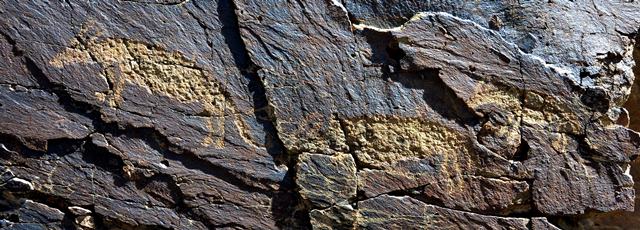
Fig. 19. Three wild carnivores
Taxa: possibly wolves
Prominent motifs: arched back; downward pointing tail, slightly curled at end; upright ears; pointed muzzle; four unflexed legs
Body: silhouetted
Technique: deeply carved
Region: Far Western Tibet
Estimated Age: Protohistoric period
Additional details: These wild carnivores appear to be stalking prey but no other figures are visible in the vicinity. They are also illustrated in the January 2014 (fig. 57) Flight of the Khyung.
Group 3: Possible wild carnivores
This group includes a selection of animals that may possibly represent wild carnivores. These petroglyphic compositions include solitary figures and those in groups. They are included in this article to illustrate the difficulties involved in identifying certain animal carvings.
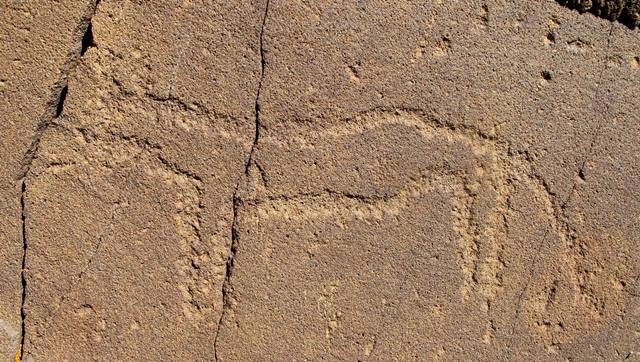
Fig. 20. Wild quadruped
Taxa: carnivore or equid
Prominent motifs: double curved back; downward pointing tail; upright ears; squared muzzle; two unflexed legs
Body: outlined
Technique: deeply carved
Region: Far Western Tibet
Estimated Age: Iron Age
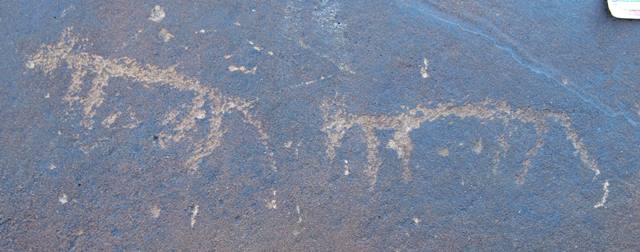
Fig. 21. Pair of wild quadrupeds
Taxa: carnivores or equids
Prominent motifs: flat back; downward pointing tail; upright ears; square/pointed muzzle; four unflexed legs
Body: silhouetted
Technique: moderately carved
Region: Far Western Tibet
Estimated Age: Iron Age or Protohistoric period
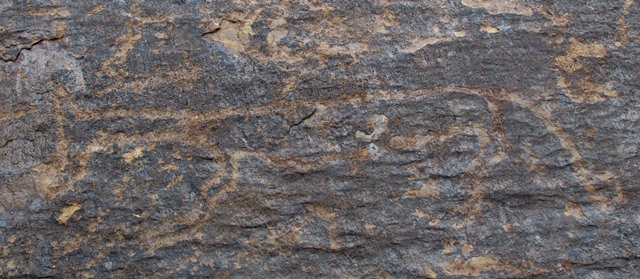
Fig. 22. Wild quadruped among many other animals including wild felines (not pictured)
Taxa: carnivore or equid
Prominent motifs: flat back; downward pointing tail; upright ear; pointed muzzle; two flexed legs
Body: outlined, elongated
Technique: moderately carved
Region: Far Western Tibet
Estimated Age: Late Bronze Age or Iron Age
Additional details: See fig. 28 for the wider pictorial context.
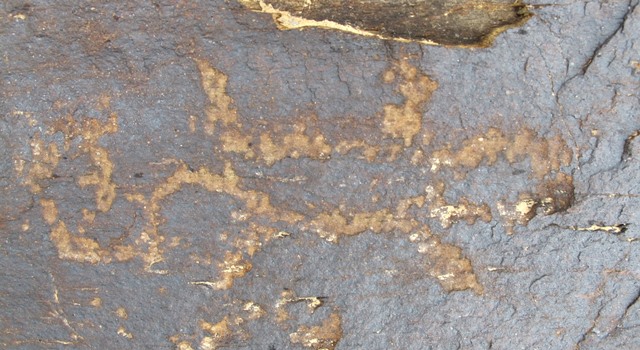
Fig. 23. Wild quadruped
Taxa: lizard or carnivore from overhead perspective
Prominent motifs: curling tail, spiral at end; oval head; four unflexed legs
Body: outlined
Technique: moderately carved
Region: Far Western Tibet
Estimated Age: Iron Age
Additional details: There are several compositions in Far Western Tibet and the Western Changthang depicting one or two animals as seem from above. Some of these subjects strongly resemble lizards, whose habitat includes rocks hosting rock art. The overhead perspective assumed by the petroglyphs in fig. 23 (and fig. 24) recalls lizards scuttling over stone surfaces.
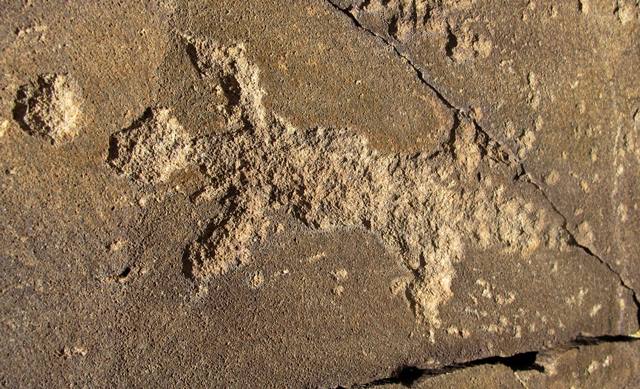
Fig. 24. Wild quadruped and circular subject
Taxa: lizard or carnivore from overhead perspective
Prominent motifs: broad, straight tail; round head; four squat legs
Body: silhouetted
Technique: deeply carved
Region: Far Western Tibet
Estimated Age: Iron Age
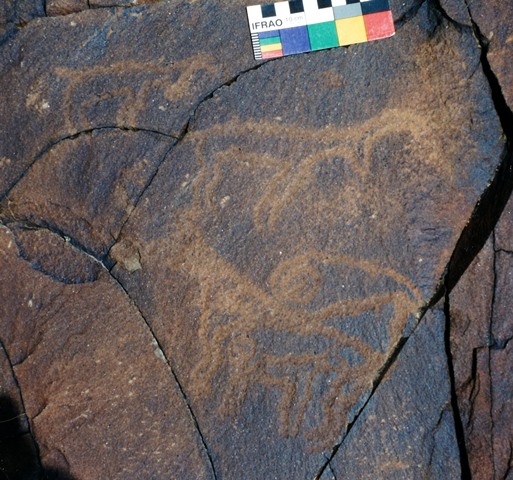
Fig. 25. Possible wild carnivore (lowermost figure) and two wild ungulates
Taxa: carnivore or bovid
Prominent motifs: concave back; tail overarching back, spiral at end; upright ears or horns; squared muzzle; four flexed/unflexed legs
Body: partially silhouetted
Technique: moderately carved
Region: Far Western Tibet
Estimated Age: Iron Age
Additional details: Although the tail of the lowermost figure recalls those of felines, its body shape resembles that of the wild yak. The middle figure has horns in front of the head that curve outward, in a fashion strongly suggestive of the antelope (gtsod). The upper figures may possibly be a depiction of the wild ass (rkyang).
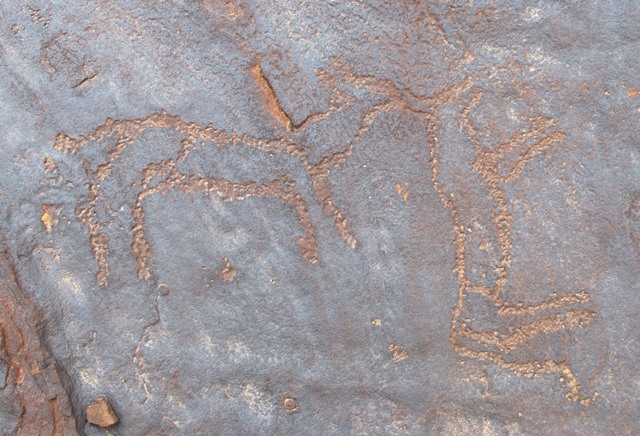
Fig. 26. A pair of wild quadrupeds
Taxa: carnivore or equid
Prominent motifs: double curved back; downward pointing tail, curled at end; upright ears; rounded/squared muzzle; four unflexed legs
Body: outlined
Technique: moderately carved
Region: Western Changthang
Estimated Age: Iron Age
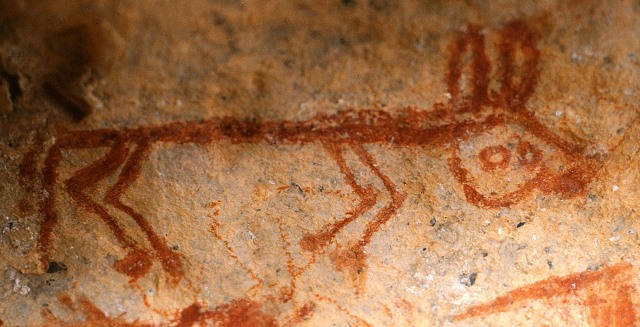
Fig. 27. Wild quadruped
Taxa: carnivore or equid
Prominent motifs: flat back; downward pointing tail; upright ears; two eyes; rounded muzzle; four flexed legs with feet
Body: stick figure
Technique: painted, red ochre
Region: Eastern Changthang
Estimated Age: Early Historic period or Vestigial period
Next Month: More wild carnivores in the rock art of Upper Tibet, plus exploring the mysteries of the first riding horses in Inner Asia!